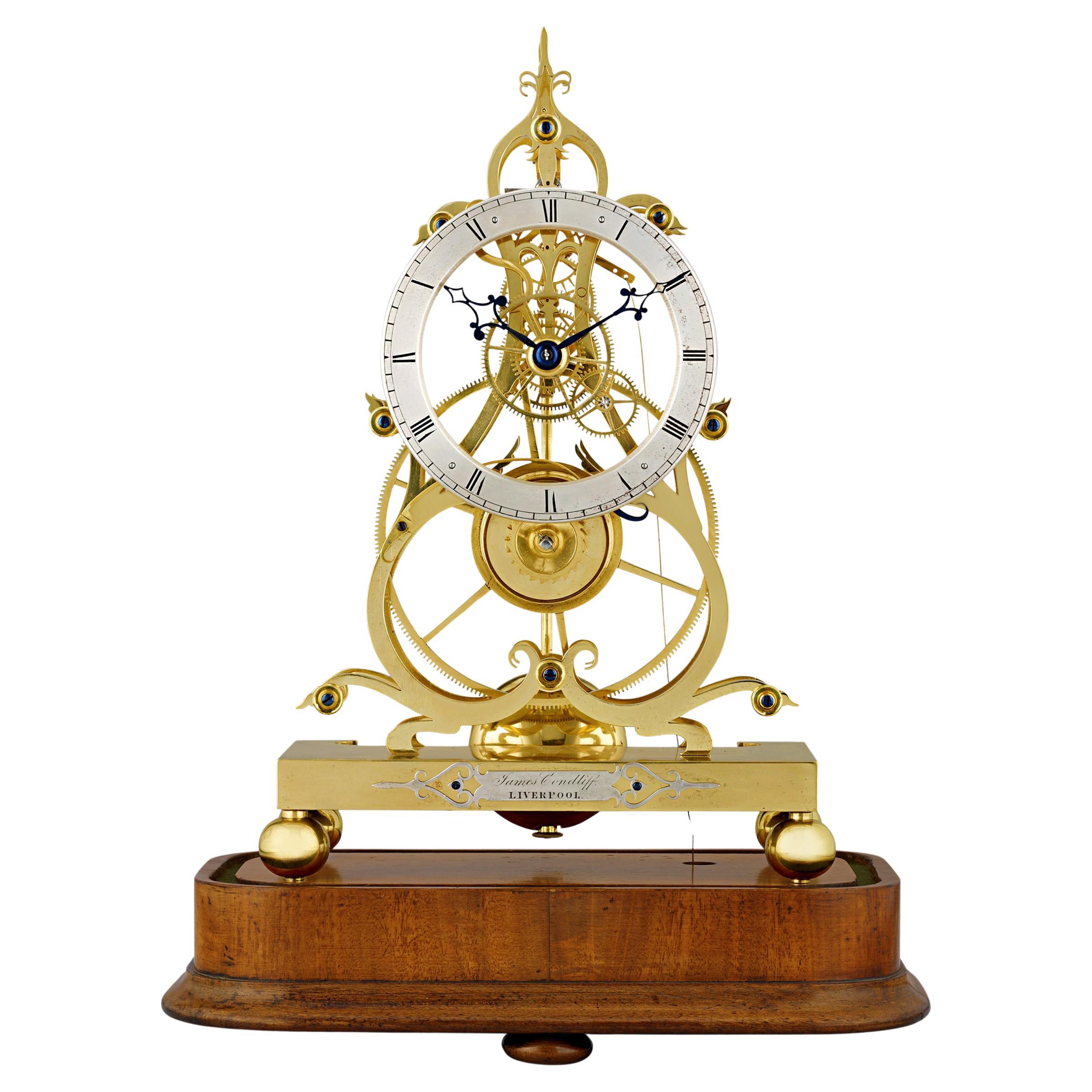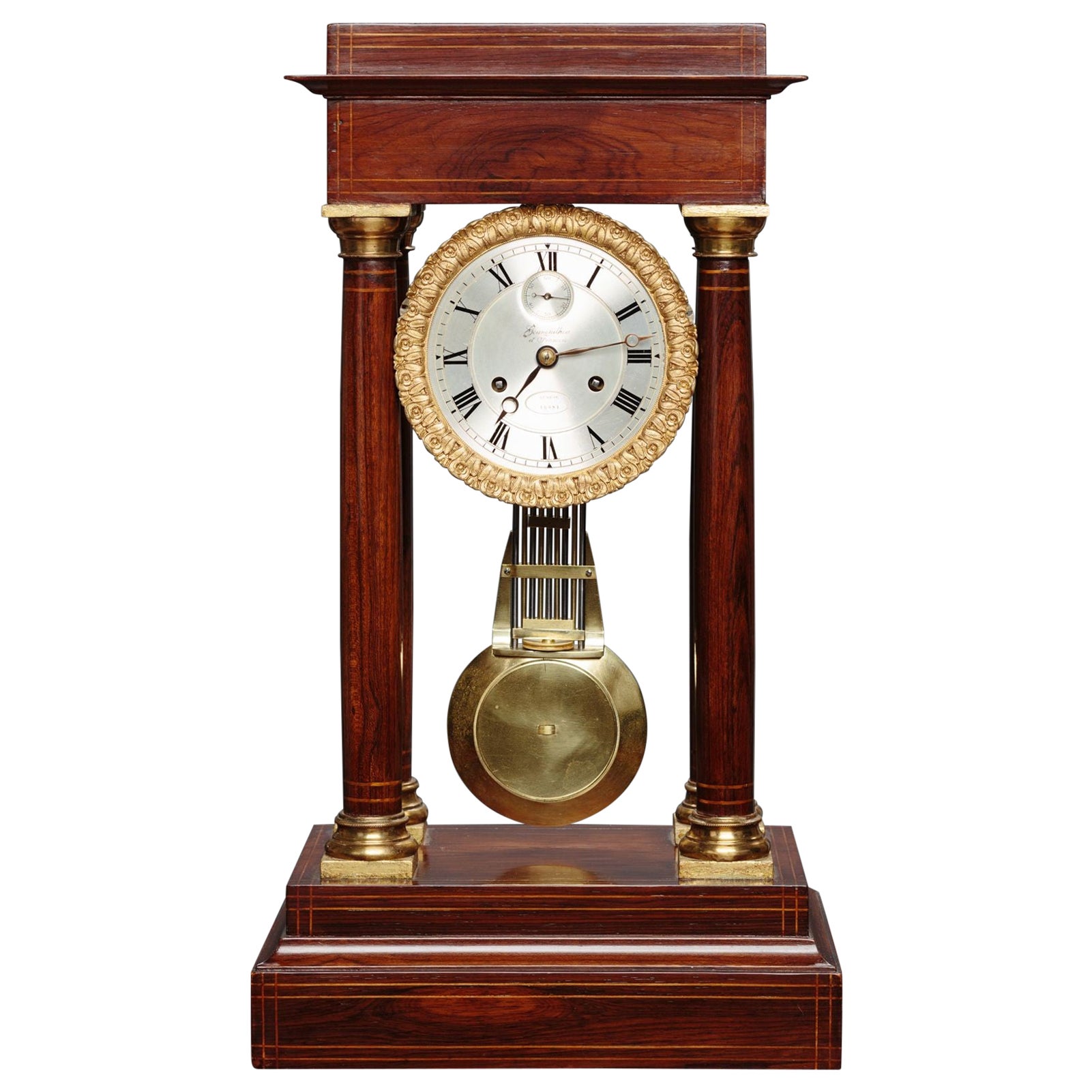Items Similar to James Condliff Skeleton Table Regulator Clock
Want more images or videos?
Request additional images or videos from the seller
1 of 6
James Condliff Skeleton Table Regulator Clock
About the Item
A horologic masterpiece of precision and beauty, this Victorian-era skeleton clock is an extraordinary example of 19th-century British clockmaking by the famed James Condliff of Liverpool. Regarded as the father of the English skeleton clock, Condliff is celebrated as the first English clockmaker who specialized in these highly complex timepieces. Brilliantly conceived and of the finest quality, his timekeepers were individually made, and no single one is exactly the same. His process was so complex and painstaking that he produced a relatively small number of these timepieces during his lifetime; only about 70 of his skeleton clocks exist to this day.
The timepiece is further distinguished by its design. Condliff created only a small handful of these table regulators around 1845; by 1850, he veered away from this design, adopting instead the then-popular tall, slender frame that is more recognizable today. This example, by contrast, boasts a wide architectural frame resting on well-turned brass columns at each corner. The wheel train is held within a pair of arched brass plates, while a gilt brass serpent pins the movement's spring, adding visual intrigue. Three slender, silvered dials display the time in an unusual configuration. The first indicates the hours, the second the minutes, and the last displays the seconds, all with Roman numerals and blued steel hands.
The clock was almost certainly made by Condliff especially for Edward Scales, a clockmaker based in Manchester who crafted the timepiece's escapement. The base is engraved "Patent Detached Lever Edward Scales Old Church Yard Manchester" — the prominence of the engraving not only reflects Scales' pride in his patent lever escapement but also indicates that he was likely the clock's retailer.
Circa 1845
Measures: Clock: 9 1/4" wide x 4 1/2" deep x 11 3/4" high
Case: 13 1/2" wide x 7 1/2" deep x 17" high.
- Dimensions:Height: 17 in (43.18 cm)Width: 13.5 in (34.29 cm)Depth: 7.5 in (19.05 cm)
- Style:Victorian (Of the Period)
- Materials and Techniques:
- Place of Origin:
- Period:
- Date of Manufacture:circa 1845
- Condition:
- Seller Location:New Orleans, LA
- Reference Number:
About the Seller
5.0
Recognized Seller
These prestigious sellers are industry leaders and represent the highest echelon for item quality and design.
Established in 1912
1stDibs seller since 2010
93 sales on 1stDibs
Typical response time: 7 hours
- ShippingRetrieving quote...Ships From: New Orleans, LA
- Return PolicyThis item cannot be returned.
More From This SellerView All
- Skeleton Clock By James CondliffLocated in New Orleans, LAThis exceptional timepiece is a Victorian-era skeleton clock crafted by James Condliff of Liverpool, a luminary in the realm of 19th-century British horology. Condliff was distinguis...Category
Antique 19th Century English Victorian Mantel Clocks
MaterialsBrass
- Louis XVI Style Grand Regulator ClockLocated in New Orleans, LAThis monumental longcase regulator clock crafted in the resplendent Louis XVI style is both a marvel of horological innovation and a paragon of arti...Category
Antique 19th Century French Louis XVI Grandfather Clocks and Longcase Cl...
MaterialsEnamel
- Month-Going Regulator Clock by Deshays à ParisLocated in New Orleans, LAThis Louis-Philippe-period month-going longcase regulator clock is an exceptional example of French clockmaking, and its complicated mechanism marks several different aspects of passing time. Crafted by Deshays à Paris, the timepiece displays sleek silvered steel dials that indicate the time, date, month, equation of time...Category
Antique 19th Century French Louis Philippe Grandfather Clocks and Longca...
MaterialsSteel
- French Great Wheel Skeleton ClockLocated in New Orleans, LAThis important glass-fronted French Empire great wheel skeleton clock has the remarkable ability to run with incredible accuracy for more than a week on a single winding. The large central wheel and the rare combination of the pin-wheel escapement and knife-edge suspension allow for a longer, more accurate running time than most clocks of the period. The clock is further distinguished by the inclusion of a concentric calendar dial and Roman numeral chapter ring set amidst a stunning floral halo of gilt bronze fretwork, all mounted on a bronze-wrapped marble base. In such fine, working condition, and with the inclusion of a period glass dome, this clock is exemplary of the finest French skeleton...Category
Antique 19th Century French Table Clocks and Desk Clocks
MaterialsMarble, Bronze
- Breguet Month-Going Long Case Regulator ClockLocated in New Orleans, LACompleted on December 31st, 1931, this Breguet mahogany and brass floor month-going regulator clock is a perfect emblem of Breguet’s Art Deco and mechanical excellence during the important interwar period. Adorned with the hallmark Breguet features, including the famous moon tip Breguet hands and a beautifully polished brass frame, the clock is further enhanced with exquisite decoration on the plates. Featuring the most accurate escapement of its time, this month-going regulator stands as one of the most dependable timekeepers of its day. Its design even excludes a chime to...Category
20th Century Swiss Art Deco Grandfather Clocks and Longcase Clocks
MaterialsBrass
- Regulator Clock by Jean-Aimé Jacob and Adam WeisweilerLocated in New Orleans, LAThis important regulator clock beautifully demonstrates the heights of precision clockmaking. While regulator clocks are known for their incredible acc...Category
Antique 19th Century French Louis XIV Grandfather Clocks and Longcase Cl...
MaterialsEbony, Mahogany
You May Also Like
- George III Mahogany Regulator ClockLocated in Bradford-on-Avon, WiltshireA Regulator clock by William Chisholm, London. Baillie has no record of the maker but by the design of its original case, we believe it to be late 18th century circa 1790. The 8 day ...Category
Antique 1790s English George III Grandfather Clocks and Longcase Clocks
MaterialsMahogany
- Mahogany Regulator Longcase Clock of Month DurationLocated in Norwich, GBRegulator longcase clock of month duration Early Victorian mahogany regulator standing on a raised, moulded plinth with centre panel to the b...Category
Antique 19th Century British Victorian Grandfather Clocks and Longcase C...
MaterialsMahogany
- Rosewood Portico Regulator Mantel ClockLocated in Norwich, GBRosewood Portico Regulator Mantel Clock Housed in a fine quality Rosewood portico case with boxwood stringing, turned pillars with brass capitals, gilded cast foliate bezel and stan...Category
Antique 1840s Swiss Mantel Clocks
MaterialsRosewood
- Grand Exhibition Skeleton ClockLocated in HAARLEM, NLA charming miniature, skeletonised timepiece made for the Grand Exhibition in Paris of 1889. The lovely and finely engraved bronze skeletonised frame and beautiful matching engraved ...Category
Antique Late 19th Century French Mantel Clocks
MaterialsBronze
- French Skeleton Mantel ClockLocated in Norwich, GBFrench Skeleton clock with Gothic style brass frame standing on a marquetry inlaid rosewood base with bun feet. Cherubs head pendulum bob, enamel dia...Category
Antique 1850s French Napoleon III Mantel Clocks
MaterialsBrass
- Vienna Regulator, Grand Sonnerie Wall Clock in WalnutBy Vienna BronzeLocated in Perth, GBIn the noted horology book "Britten's Old Clocks and Watches", G.H. Baillie defines a Grand Sonnerie movement as follows: "A form of quarter-striking in which the hour last struck is also repeated at each hour." It works like this, striking the quarter-hour on one gong and the hour on a second, slightly lower-toned gong: At 3:15 the clock strikes once on the higher chime to indicate the quarter hour, followed by three strikes on the lower chime to indicate the hour. At 3:30 the clock strikes two times on the higher chime (half-hour), followed by three chimes on the lower gong (hour). This way, if you are within hearing distance of the clock, day or night, you can tell exactly what time it is at each quarter hour A "petite sonnerie...Category
Antique Late 19th Century Austrian Late Victorian Furniture
MaterialsWalnut
Recently Viewed
View AllMore Ways To Browse
Small Clock
Used Skeleton
Circa Timepiece
Antique Roman Numeral Clock
Hes Clock
Quality Antique Clocks
Antique Time Clocks
Antique Time Clock
Antique Time Clock Clocks
All Antique Clocks
Antique Silver Clock Antique Clocks
Antique Silver Clock
Silver Clock Antique Clocks
Antique Clock Designs
Antique Table Clocks Clocks
Antique Table Clock Clocks
Object No11
Small Clocks





